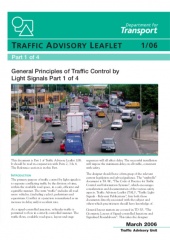General Principles of Traffic Control by Light Signals - TAL 1/06
Document types:
Document weight:
Document geography:
Geographical spread:
Tags:
The primary purpose of traffic control by light signals is to separate conflicting traffic by the division of time, within the available road space, in a safe, efficient and equitable manner. The term “traffic” includes all road users: vehicles, (including cycles), pedestrians and equestrians. Conflict at a junction is manifested as an increase in delay and/or accident rate.
At a signal-controlled junction, vehicular traffic is permitted to flow in a strictly controlled manner. The traffic flows, available road space, layout and stage
sequences will all affect delay. The successful installation will impose the minimum delay on all traffic, consistent with safety.
The designer should have a firm grasp of the relevant current legislation and advice/guidance. The “umbrella” document is TA 841, “The Code of Practice for Traffic Control and Information Systems”, which encourages consideration and documentation of the various safety aspects. Traffic Advisory Leaflet (TAL)2, “Traffic Light Signals - Relevant Publications”, lists both those documents directly associated with the subject and others which practitioners should have knowledge of.
General layout matters are covered in TD 503, “The Geometric Layout of Signal-controlled Junctions and Signalised Roundabouts”. This takes the designer through the early considerations, such as the intervisibility, lane widths, swept paths of vehicles etc. TD 503 was written for trunk road junctions and although the advice given will also be applicable to many other junctions, there will be exceptions. For example, some junctions are signal- controlled because there is poor intervisibility, which cannot reasonably be improved and a priority junction would not be safe. Therefore, some of the advice given in TD 503, on subjects such as intervisibility needs to be considered pragmatically. Decisions may be justified because of the existing/desired topography, or to help deliver a desired design speed. The Manual for Streets, currently in preparation, is developing this approach, adopting a different approach to road design by creating environments which dictate the prevailing speed of vehicular traffic rather than try to accommodate it.
This document follows on from TD 503, considering the detail. It is necessary to read TAL 5/054, “Pedestrian Facilities at Signal-controlled Junctions” with this document and there are others, such as TAL 2/035, “Signal- control at Junctions on High-speed Roads”, which should be referred to as necessary.
Compared with other western countries Great Britain (GB) has a good accident record at signal-controlled junctions. This is certainly in part, if not mainly, due to a consistent system of signalling for a given circumstance. It is important that all displays must be clear and unambiguous.

